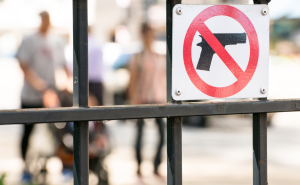New Research Shows Your ZIP Code Could Make You 27 times More Likely to be Fatally Shot by Police
A new study found that an individual’s ZIP code for their residence could indicate their risk of being fatally shot by police.

A new study from researchers at the Johns Hopkins Center for Gun Violence Solutions at the Bloomberg School of Public Health and the University of Maryland Global Campus School of Business found that an individual’s ZIP code for their residence could indicate their risk of being fatally shot by police. The study analyzed 6,901 fatal police shootings between 2015 and 2022 across 32,736 ZIP codes that had publicly available demographic, socioeconomic and police shooting data, which accounts for 79% of U.S. ZIP codes. Findings show those at highest risk are 27 times more likely to be fatally shot by police than those at lowest risk.
Researchers used the Social Vulnerability Index (SVI) to categorize ZIP codes, the index data was calculated following the Center for Disease Control’s methodology and using measures from the American Community Survey. Determining SVI factors include socioeconomic status, household composition and disability, minority status and language, and housing type and transportation. The accessibility of firearms also was a contributing factor to increased rates/incidents of fatal police violence. This new research provides a first-ever nationwide analysis of fatal police shootings at the ZIP code level. The study findings highlight the pressing need to address social vulnerability and racial disparities in police shooting rates, emphasizing the connection between accessibility of guns and racial structural injustices in police interactions, especially in communities of color.
“Our findings reveal stark and alarming disparities in fatal police shootings that cannot be attributed to a single factor,” says Hossein Zare, PhD, MS, associate research professor at the Johns Hopkins Bloomberg School of Public Health and lead author of the study. “Instead, they reflect the intersection of social vulnerability, race, and geography. By analyzing these complex dynamics at the ZIP code level, we aim to highlight the urgent need to address the structural inequities that disproportionately place communities of color and socially vulnerable populations at higher risk. Only by tackling these root causes can we reduce fatal police violence and promote a more equitable system of justice.”
While the largest disparities in policing were seen in race as a factor, findings suggest the intersection of social vulnerability and the racial composition of a ZIP code independently influence the risk of fatal police shootings. Researchers say the underlying determinants of disparities should be addressed in order to make holistic efforts to prevent gun deaths by police in vulnerable communities.
The study examined 6,901 fatal police shootings within 32,736 ZIP codes from 2015 to 2022 using Mapping Police Violence Data and Washington Post Fatal Force Data repositories. The analysis observed an average Social Vulnerability Index of 0.51. Researchers assigned ZIP codes with scores of <0.34 or lower as low SVI, 0.34-0.67 as moderate SVI, and >0.67 for high-SVI categories. Fatal police shootings rose significantly, by 8.3 times, from 557 to 4,622 individuals as SVI levels increased from low to high, with the most notable spikes seen in Hispanic (27.1 times) and Black (20.4 times) populations. Researchers say this disparity worsens mental and physical well-being and negatively impacts life expectancy in communities of color.
In 2022 alone, an estimated 1,096 people were fatally shot by police in the U.S., and those individuals were disproportionately Black and Hispanic, males, or living in areas with high rates of unemployment and social vulnerability.
The study was published online on September 11th in the American Journal of Preventative Medicine.
The new findings also suggest that in comparison to areas with lower access to firearms, fatal police shootings were higher in areas with medium to very high access to guns. The analysis found a positive correlation between firearm accessibility and rates of fatal police shooting. Furthermore, the analysis found that violent crime in a ZIP code was a predictor for increased deadly police shootings. ZIP codes with the highest levels of violent crime had 1.79 times more fatal shootings by police.
The study’s authors say policies such as regulations on public carry, firearm purchaser licensing, and community violence intervention programs that address the prevalence of guns and gun violence may reduce fatal police shootings specifically in socially vulnerable communities. Policymakers should consider strategies to reduce fatal police shootings focusing on social vulnerability factors that disproportionately impact Black and Hispanic communities.
Analyzing racial and socioeconomic differences is crucial to understanding and addressing disparities in deadly police interactions. A thorough examination of SVI factors is paramount for effectively addressing the complex dynamics that contribute to fatal police shootings in our country.
The authors note that the study has limitations because it uses fatal police shooting data from accessible sources that may not be complete. Other limitations include data precision, completeness, and consistency due to varied data collection practices across jurisdictions.
“Analyzing Fatal Police Shootings: The Roles of Social Vulnerability, Race, and Place in the US” was authored by Hossein Zare, Andrea N. Ponce, Rebecca Valek, Niloufar Masoudi, Daniel Webster, Roland, J. Thorpe Jr., Michelle Spencer, Cassandra Crifasi, and Darrell Gaskin.
The study was funded by the Bloomberg American Health Initiative. Part of Cassandra Crifasi and Daniel Webster’s funding came from the Robert Wood Johnson Foundation.




